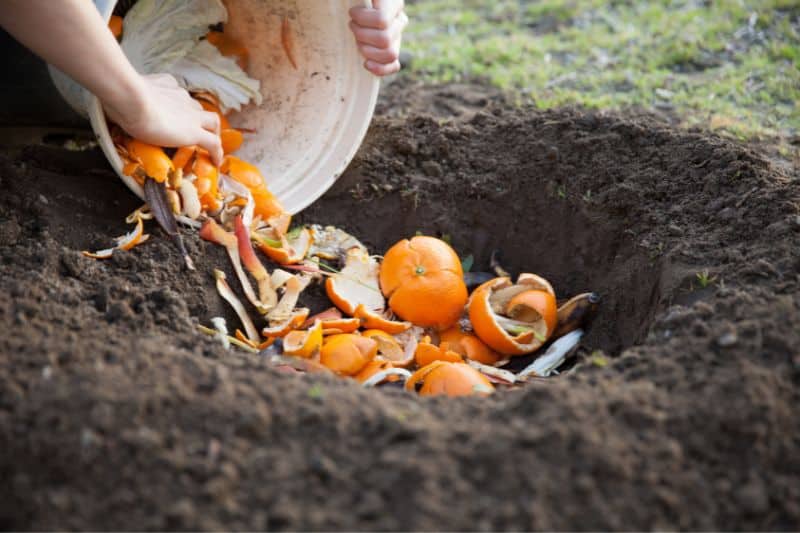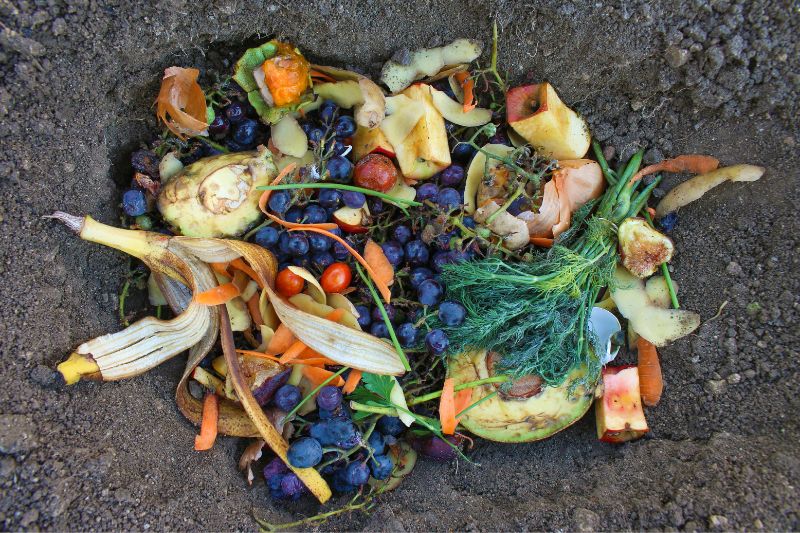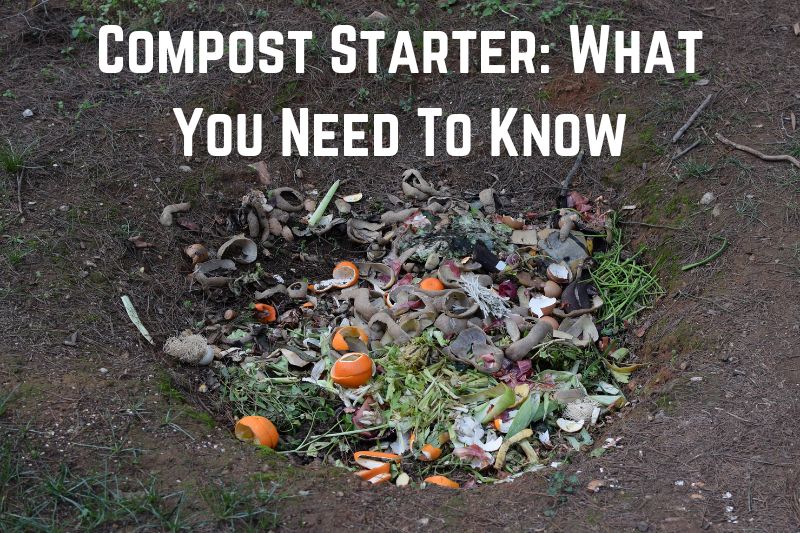Composting is a fantastic way to recycle organic waste and create nutrient-rich soil for your garden. Understanding the importance of a compost starter will aid you in initiating and maintaining a successful composting process.
Several types of compost starters are available, ranging from commercially produced to homemade concoctions. Selecting the right starter that will work well with your specific composting requirements and the materials you plan to compost is essential.
Let’s delve into compost starters and how they can benefit your composting journey. In the following sections, we’ll explore the various options and help you decide on the best compost starter for your needs.
Read: Compost is Too Wet (Soggy): What To Do?
What is a Compost Starter?
A compost starter, or activator, is a substance added to your compost pile to kickstart the decomposition process. It typically contains a mix of beneficial microorganisms, including bacteria, fungi, and other organisms that break down organic matter into nutrient-rich soil.
Compost starters can be purchased commercially or made at home by combining materials such as manure, soil, and vegetable scraps. Adding a compost starter to your compost pile can help speed up the composting process and produce high-quality compost that is rich in nutrients and beneficial for plants.
Importance of Compost Starters
A compost starter is an essential ingredient to kickstart your composting process. It provides the necessary microorganisms and nutrients to accelerate the breakdown of organic materials in your compost pile.
Using a compost starter can significantly speed up the decomposition and increase the temperature in your compost pile, leading to a more efficient and effective composting process. So, whether you’re a seasoned composter or just starting out, a compost starter is an excellent addition to your composting toolkit.
Components of a Good Compost Starter
A high-quality compost starter usually contains essential ingredients that meet the requirements for effective decomposition. When selecting a compost starter, ensure it contains the following components:
- Microorganisms: Beneficial bacteria, fungi, and other microorganisms are essential for breaking down organic matter. A good compost starter should contain diverse microbes that can thrive in varying conditions and target different materials.
- Nutrients: Decomposition requires nutrients to fuel microbial growth and activity. Key nutrients such as nitrogen, phosphorus, and potassium are necessary for successful composting. Choose a compost starter with a balanced N-P-K ratio to promote efficient decomposition.
- Organic Matter: A compost starter should include some organic matter to jumpstart decomposition. This might include aged manure, grass clippings, and other plant-based materials.
Do You Really Need a Compost Starter?
The simple answer is both yes and no. It’s contradictory. Let’s dive more into it.
A compost starter is unnecessary if you get the proper ratio of greens to browns. However, it can be especially useful if you find it challenging to mix organic matter, water, and air in a balanced way.
Suppose you maintain the proper balance of greens (nitrogen-rich materials) and browns (carbon-rich materials) in your pile, along with ensuring adequate moisture and aeration. In that case, the composting process will occur naturally over time.
In some cases, using a compost starter might speed up the process, especially when starting a new compost bin in colder weather. However, this is not always the case, and the effect can vary depending on your composting conditions and the specific compost starter product.
There are several varieties of compost starters, including:
- Artificial activators that aid in speeding up bacterial activity include nitrogen-rich compounds.
- Natural ingredients such as seaweed extract or manure are used as compost starters to get the process started.
To summarize, while a compost starter can potentially speed up the process in certain situations, maintaining a good balance of greens and browns, moisture, and aeration should suffice for a healthy compost pile. If you decide to try a compost starter, choose one that fits your needs and always follow the instructions provided.

What is Compost Starter Made of?
Compost starter, also known as compost activator, is a substance that helps speed up the composting process. It’s made of various ingredients, which can be both organic and inorganic. This section will discuss the common components found in compost starters.
First, microorganisms play a significant role in compost starters. These beneficial bacteria and fungi help break down organic materials in your compost pile, turning them into nutrient-rich humus. Some compost starters contain a blend of microbes specially selected for their ability to break down various materials.
Next, it’s essential to have a good balance of nitrogen and carbon in your compost pile to provide an ideal environment for decomposition.
Many compost starters include nitrogen-rich ingredients, such as alfalfa meal, soybean meal, or blood meal, to give your compost pile the necessary nutrients. Furthermore, they might also have carbon-rich ingredients, such as shredded newspapers or sawdust, which provide the microbes with a vital energy source.
In addition to nutrients, compost starter can contain buffering agents like lime or gypsum. These are added to create a more neutral pH level in the compost pile, allowing the microorganisms to thrive.
Lastly, some compost starters may include a mix of enzymes or humic acids. These substances can enhance the composting process by aiding in the breakdown of complex organic materials and improving the overall structure of the finished compost.
By using compost starter, you can improve the efficiency of your composting process and create a better end product. Just remember to follow the instructions for mixing and application the manufacturer provides for your compost starter.
Process of Using Compost Starters
Preparation
Before using a compost starter, you should gather all the materials needed for a successful composting process. Collect a mix of greens (nitrogen-rich materials like fruit and vegetable scraps, coffee grounds, or grass clippings) and browns (carbon-rich materials like leaves, straw, or small twigs). Ensure you have a suitable container or designated area for your compost pile.
Application
Once your materials are gathered, you can begin applying the compost starter. Follow these steps:
- Layer your materials: Start by creating a base layer of browns, then add a layer of greens on top. Alternate between layers of browns and greens, trying to balance the two.
- Apply the compost starter: Sprinkle it evenly across your compost pile or mix it directly into your layers. Make sure to follow the instructions on the packaging for the correct amount needed for your pile size.
- Moisten the pile: Lightly moisten the entire pile using a garden hose. The moisture helps activate the compost starter and encourages the decomposition process.
Maintenance
To ensure optimal results from your compost starter, follow these maintenance tips:
- Turn the pile regularly: Use a pitchfork or shovel to mix and turn the pile once a week. This introduces oxygen, which accelerates decomposition.
- Check moisture levels: Ensure your compost pile stays moist but not overly wet. Add water if it appears too dry, or mix in more browns if it’s too wet.
- Monitor the temperature: A successful compost pile will generate heat as it breaks down. You can use a compost thermometer to measure the temperature. If the temperature drops, turn the pile more frequently or add more greens to heat it up.
Types of Compost Starters
Storebought Versus Homemade Compost Starters
When starting a compost bin, you might wonder whether to use a store-bought compost starter or make a homemade one. Both have their benefits and understanding the differences can help you make the best choice for your composting needs.
Storebought compost starters are readily available and come in various forms, such as granules, powders, and liquids. They contain beneficial microorganisms that quickly break down organic material in your compost bin. As a result, you’ll see faster decomposition and decrease the likelihood of unpleasant buildup.
On the other hand, homemade compost starters can be an economical and environmentally friendly option. Using materials such as garden soil, previously composted materials, or even crushed eggshells provides your compost bin with the necessary nutrients and microorganisms to start the decomposition process.
Determining the Best Type for Your Needs
To determine the best compost starter type for your needs, consider the following factors:
- Time: If you’re short on time, a storebought compost starter can quickly get your compost pile going. Depending on the materials you use, homemade starters might require more time to prepare.
- Budget: Homemade compost starters are generally more cost-effective as they usually require materials you already have. Storebought starters might be more expensive, but the convenience might be worth the extra cost.
- Environmental impact: If being eco-conscious is important to you, homemade compost starters can be a more sustainable choice. Storebought starters often come in plastic containers, which can contribute to plastic waste.

Best Practices for Using Compost Starters
Suitable Materials
To achieve the best results when using compost starters, you should include various materials in your compost pile. These materials can be categorized into two groups: greens and browns.
- Greens: Rich in nitrogen, these materials help to promote decomposition. Examples include:
- Fruit and vegetable scraps
- Coffee grounds
- Grass clippings
- Young weeds
- Browns: High in carbon, these materials provide structure and balance to your compost pile. Examples include:
- Dry leaves
- Small branches and twigs
- Cardboard and newspaper
- Bamboo Straw
Strive for a balance between greens and browns, aiming for a ratio of 2:1 (greens). This balance will provide the appropriate conditions needed for effective decomposition and will already be included in most compost starters to ensure proper composting in your pile.
Avoiding Composting Mistakes
To maximize the effectiveness of compost starters and maintain a healthy compost pile, it’s essential to avoid common mistakes.
- Aeration: Your compost pile requires oxygen for efficient decomposition. Regularly turn the pile or mix it with a pitchfork or compost aerator tool. This will help prevent unpleasant odors and ensure a properly functioning composting process.
- Moisture: Your compost pile should have the consistency of a wrung-out sponge. Too much moisture can lead to anaerobic conditions and unwanted smells, while too little moisture can hinder decomposition. Adjust the balance of moisture by adding more greens (for additional moisture) or more browns (to absorb excess moisture).
- Location: Choose a well-draining area for your compost pile or bin. Avoid placing it directly on concrete or asphalt since this can interfere with composting.
- Avoid using harmful materials: Certain materials should not be added to your compost, as they can negatively impact the quality of the end product or attract pests. Do not include:
- Meat, dairy, or bones (they can attract pests)
- Diseased plants (could spread disease to future plants)
- Chemically treated wood or yard waste (chemicals may not fully break down and can harm plants)
By adhering to these best practices and using compost starters with the specified materials, you’ll be well on your way to creating high-quality, nutrient-rich compost for your garden.
Read: Should Compost Have Flies? (Answered)
How To Make Your Compost Starter?
Additionally, some creative gardeners create their mixtures to be employed as compost activators. The following ingredients make up a typical ingredient list:
- Two or three gallons of water
- One little beer bottle
- An equal amount of ammonia
- One sweet soda can (not diet)
Making your own compost starter is a simple and eco-friendly way to create nutrient-rich soil for your garden. In this section, we’ll guide you through the process. Let’s get started!
First, gather all the necessary ingredients. You’ll need a mix of both green and brown materials. Green materials provide nitrogen and include items like fruit and vegetable scraps, coffee grounds, and grass clippings. Brown materials are high in carbon and include things like dried leaves, straw, and small branches. A good ratio to maintain is two parts brown to one part green.
Next, find a suitable location for your compost. Choose an area that’s level, well-drained, and shaded. Place your compost on bare soil to allow worms and other beneficial organisms to access it easier.
Now it’s time to build your compost pile. Start by creating a layer of brown materials about 4 to 6 inches thick. Add a layer of green materials on top, followed by a thin layer of garden soil or finished compost. This helps introduce beneficial microorganisms to kick-start the decomposition process.
Continue to layer green and brown materials, occasionally adding a layer of soil or finished compost. Try to maintain that two-to-one ratio of brown to green materials. As you add layers, occasionally water your pile to keep it moist but not soggy. The moisture will help the microorganisms break down the materials.
Once your compost pile is built, turn the heap every few weeks to aerate it and mix the materials. This promotes a faster decomposition process. Use a garden fork or shovel to mix the materials, and ensure that the pile stays damp.
Lastly, monitor the temperature of your pile. During the decomposition process, your compost pile will generate heat. When the center reaches 130°F to 150°F (roughly 55°C to 65°C), this indicates that the composting process is in full swing. If the temperature starts to drop, it’s time to turn the heap and add more green materials.
After a few months, your compost pile will transform into a rich, dark, and crumbly substance. At this point, it’s ready to use as a nutrient-rich compost starter for your garden.






